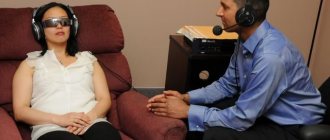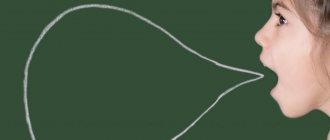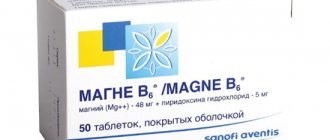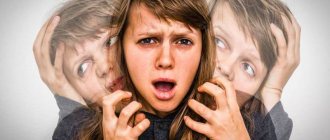When it comes to neurosis, almost each of us has a rough idea of what it is and what causes it. But the diagnosis of “neurosis-like syndrome” can confuse not only the patient, but even some doctors. What is this condition and how can you fight it?
As in the case of neuroses, neurosis-like syndrome does not have an ICD-10 code. That is, official medicine does not recognize such a concept. However, this does not mean that it does not exist; simply, symptoms similar to neurotic ones accompany the course of many diseases and organic pathologies.
The peculiarity of neurosis-like syndrome (NS) is that it does not occur after psychological trauma or against the background of chronic stress, like ordinary neurotic-level syndromes. On the contrary, “nervous” symptoms occur due to some real, non-psychological illness. Neurosis-like syndrome has no psychological causes, although a particular patient may have an innate predisposition to the occurrence of such a syndrome.
It is believed that NS can manifest itself in any serious illness. Let's list just a few of them:
- Bronchial asthma, food or skin allergies.
- Endocrine and hormonal disorders such as diabetes or hyperthyroidism.
- Some brain defects.
- Diseases of the liver, gall bladder and pancreas.
- Cardiovascular diseases.
- Diseases of the gastrointestinal tract (stomach ulcer, gastritis, dysbacteriosis).
- Mental illnesses such as schizophrenia, paranoid syndrome, etc.
Children have their own “list” of specific age-related (and not only) deviations that can also cause NS:
- intrauterine development disorders;
- influence of negative factors on the unborn child (smoking, alcohol, etc.);
- hereditary inferiority of certain systems and parts of the brain;
- birth injuries;
- nervous diseases suffered in early childhood.
In general, neurosis-like syndrome is considered by specialists to be an intermediate state between neurosis itself and organic pathology. And most often it occurs in children from 2 to 7 years old. In this case, the occurrence of NS can be associated with pathologies of brain development in the child. However, sometimes this disorder can go away on its own, as people say - the child “outgrows” it over time, since the child’s brain has enormous potential for regeneration. So after about 12 years, with the onset of puberty, the symptoms of the disorder may disappear, but you should not rely on this - treatment and prevention are necessary at any age.
Symptoms of neurosis-like syndrome
As with neuroses, it can be very extensive and varied.
A neurosis-like condition in adults is manifested by sudden mood swings, with the patient more often angry or irritable than calm and friendly. It is difficult for the patient to control his emotions and attacks of aggression. In this case, rapid fatigue and decreased concentration may be observed. All of the listed signs resemble the first and second stages of neurasthenia, but it is worth recalling that there are no psychological causes for the neurosis-like syndrome - they can only slightly increase the symptoms.
The physical manifestations of NS include:
- sleep disorders;
- constipation and loose stools;
- vomiting in stressful situations;
- lack of appetite, which can even lead to anorexia;
- changes in blood pressure and pulse;
- tearfulness, increased sweating.
As a rule, the patient is also characterized by: suspiciousness, constant anxiety and a large number of fears.
Important! For NS it is absolutely not necessary to manifest many symptoms at once - it depends on the disease that causes the syndrome, and to some extent on the personality of the patient himself, his worldview (although some experts actively reject this hypothesis, since it contradicts the main feature of a neurosis-like syndrome: not a “disease from nerves”, and “nerves from illness”).
A neurosis-like condition in children has its own characteristics and symptoms. Including:
- Hyperkinetic syndrome (attention deficit hyperactivity disorder);
- Tearfulness or aggression;
- Stool disorders, such as constipation or vice versa - diarrhea, abdominal pain;
- Increased anxiety, nightmares, fears and phobias;
- Manifestations of asthenia, decreased tone;
- Nausea and vomiting, refusal to eat;
- Enuresis, tics, stuttering;
- Excessive sweating or dry skin.
Review of the 5 main types of neurosis-like syndrome
Neurosis-like syndrome is a fairly common disease not only in adults, but also in children. It can be caused by both somatic disorders and stress, which has a provoking effect on an unfavorable organic background.
What is neurosis-like syndrome
Neuroses combine several disorders, different in their manifestations:
- Asthenic syndrome, in which a person suffers from headaches of unknown etiology. Even in the absence of stress, he quickly gets tired, gets nervous, sometimes becomes aggressive, and cannot control his emotions and actions. At night he is haunted by nightmares, anxious sleep or insomnia, during the day by drowsiness, apathy, which is replaced by irritability. Heart rhythm and digestion are disturbed, appetite disappears, a person reacts sharply to bright light and loud sounds.
- Obsessive-compulsive syndrome is expressed in unusual behavior when the patient feels an inexplicable feeling of anxiety and takes some action in an attempt to get rid of the obsessive state. A person may buy things he does not need, have intimate relationships with strangers, drink alcohol, or constantly wash his hands. Such actions do not bring him relief, yet the patient repeats them again and again. Fear becomes a frequent companion of a person, and he begins to believe in omens, signs, horoscopes, acquire amulets, etc.
- Hypochondriacal syndrome is a dangerous condition when the patient is constantly worried about his health. He is sure that he is terminally ill and will die soon. Against this background, irritability develops, headaches intensify, and digestion is upset. Such patients are sure that their karma has been spoiled, they have been damaged or cursed. They do not trust doctors and do not follow their recommendations, turning to psychics, sorcerers and other charlatans.
- Hyperkinetic syndrome is more common in children than in adults. The child is prone to destructive activity, feeling the need to set fire to something, tear, break, and run away from home. Such children have nervous tics, frequent blinking and other movements, hand tremors, and twitching. Adults can sometimes control themselves, but under stress this ability is often lost.
- Hysterical syndrome is emotional instability, excessive expression of feelings, expressed in strong demonstrative crying, moaning, pretending, mournful facial expressions, hair pulling or feigned fainting. Paresis, paralysis, deterioration of hearing and vision cannot be ruled out due to nervous conditions.
General signs and symptoms of neurosis-like conditions
Pathology can be recognized by specific signs.
Neurosis-like conditions in children
Many parents find out about this pathology too late. The first symptoms of the disease begin to appear from 2 to 7 years. Preceded by:
- pathologies at the stage of intrauterine development;
- birth head injuries;
- somatic disorders;
- drinking or smoking by a woman during pregnancy;
- CNS diseases.
Characteristic signs of pathology: all kinds of phobias, nightmares, aggression or tearfulness.
By about 12 years of age, symptoms may disappear and the disease will recede without medical intervention.
But parents should not wait for the problem to go away on its own, and timely help for a small patient is simply necessary.
Neurosis-like conditions in adults
An adult is characterized by sudden changes in mood. In the vast majority of cases, the patient is irritable and aggressive, rather than calm and friendly. It is quite difficult for him to control himself. Along with emotional stress, increased anxiety, and obsessive thoughts, there is a decrease in attention, fatigue, and sleep disturbances.
After suffering from stress, pressure changes occur, sweating increases, bowel movements are disrupted, severe vomiting and lack of appetite can occur, leading to anorexia.
Diagnostics
First of all, you should find the cause of the neurotic and neurosis-like syndrome in order to determine treatment tactics. Based on the symptoms, the neurologist prescribes a comprehensive examination, which includes an EEG and MRI of the brain. In the absence of organic lesions, we can conclude that this is a simple neurosis. In such cases, the patient should consult a psychiatrist or psychotherapist.
When making a diagnosis, one visit to a neurologist is not enough. It is necessary to contact other specialists: an endocrinologist, a gastroenterologist and a cardiologist to determine and subsequently eliminate the original cause. Only then is it advisable to begin restoring the central nervous system.
Treatment of the disease
It is necessary to take a comprehensive approach to the treatment of disorders and disorders of the nervous system. Standard therapy for adults includes the following:
- Treatment with medications to eliminate infections and lesions of an organic nature, as well as normalize the activity of the hypothalamus. The presence of phobias requires the use of tranquilizers such as Tazepam and Elenium. It is possible that antidepressants will be required, this depends on the patient’s complaints and the clinical picture.
- Physiotherapy is mandatory - electrophoresis with calcium, bromine, magnesium sulfate. It's a good idea to use electrosleep.
- After drug treatment, exercise therapy is prescribed, which is selected individually.
- Acupuncture, relaxation methods.
- Sanatorium treatment.
Children's therapy is practically no different from adult therapy, but the doctor prescribes medications only when absolutely necessary. The child needs to create a comfortable, friendly environment at home, refusing to move and other changes that could provoke a stressful situation for a small family member.
Adults are advised to get rid of bad habits and avoid conflicts if possible.
Prevention of neurosis-like disorders
Preventive measures aimed at preventing the occurrence of neurosis-like disorders, VSD, and dystonia largely consist of creating a favorable climate in the family. For adults, it is important to avoid conflict situations and excessive stress in the workplace.
Along with this, a healthy lifestyle, hardening, physical exercise, sports, proper rest and sleep at least 7-8 hours a day are of great importance. If irritating factors cannot be excluded, then you need to try to change your attitude towards them.
Source: https://eustress.ru/nevroz/nevrozopodobnyj-sindrom
Diagnosis and treatment
The first thing to do is to identify the nature of the ailment. This means that the specialist must clearly define what he is dealing with - neurosis or, nevertheless, a neurosis-like syndrome. The treatment tactics for these conditions vary quite a lot - for example, the main method of treating neuroses is working with a psychologist, but in case of a neurosis-like syndrome it will not be effective enough.
Therefore, the patient should undergo a full examination, which is prescribed based on the existing symptoms. At the first stage, this is done by a neurologist, who also prescribes an MRI of the brain and an EEG. If the results of the research do not reveal any organic pathology, then the doctor has the right to assume that we are talking about neurosis after all - and refer the patient to a psychotherapist or psychiatrist.
In case of a neurosis-like state, research will reveal abnormalities in the functioning of the brain and other body systems. The main treatment for the patient will be prescribed by a neurologist, but in some cases the help of other specialized specialists - a cardiologist, gastroenterologist, endocrinologist, etc. will be needed. This is due to the fact that first of all it is necessary to cure the root cause of the syndrome - that is, the existing organic disease, and only then (or in parallel) restore the impaired functions of the brain and nervous system in general.
The main direction in the treatment of neurosis-like syndrome is drug therapy aimed at eliminating the cause of the disease and improving brain function.
Physiotherapy is widely used, especially for the treatment of children. You may also need the help of a psychologist, since the manifestations of the syndrome themselves can be perceived quite difficult by the patient.
As part of therapy, adult patients are recommended to change their lifestyle towards a healthier one, give up bad habits and reduce the amount of stress (for example, at work). Children in the same situation need a calm and friendly atmosphere in the family, the absence of serious shocks (moving, flying on vacation, changing child care institutions or schools). During the treatment period, the patient should be in as calm an environment as possible - this will contribute to a speedy recovery.
Neurosis-like syndrome: symptoms, causes, types and treatment
As you know, most diseases develop on a nervous basis. In large cities, disturbances in the functioning of the central nervous system are no less common than the most common runny nose.
Symptoms of neurosis (irritability, lethargy and increased fatigue) sometimes appear even in people with a measured life.
Indeed, a recent or existing illness can provoke a similar clinical picture. Doctors call this condition “neurosis-like syndrome.”
Brief description of the disease
The problem of neuroses has become especially relevant today. According to official WHO data, over the past 65 years the number of registered cases has increased 24 times. During the same period, the number of mental illnesses only doubled.
The International Classification of Diseases, 10th revision (ICD-10), does not classify neurosis-like syndrome as a separate category of pathologies. Official medicine does not recognize such a concept, therefore it does not have a specific code. However, this does not mean that there is no diagnosis. It’s just that its symptoms are characteristic of many other diseases and organic lesions.
A feature of a neurosis-like state is the prerequisites for its occurrence. Pathology does not develop against the background of chronic stress or after suffering psychological trauma. On the other hand, the listed factors may play an additional role in its occurrence. The main reason is the presence of malfunctions in the body at the level of the endocrine, nervous, digestive and other systems.
Etiology of the pathological process
Most often, neurosis-like conditions arise in childhood, as well as against the background of trauma or intrauterine disorders. However, a later onset of the disease cannot be ruled out. It may be due to the following reasons:
- Mental disorders (schizophrenia, epilepsy).
- Organic brain lesions.
- Endocrine and hormonal disorders (diabetes, hyperthyroidism).
- Somatic diseases affecting the cardiovascular system, liver and gall bladder, gastrointestinal tract.
- Pathologies of an allergic nature.
- sleep disorder;
- severe vomiting after stress;
- constipation/loose stools;
- lack of appetite, which often ends in anorexia;
- pressure changes;
- increased sweating.
The occurrence of a neurosis-like syndrome cannot be considered a consequence of the diseases listed above. On the other hand, as they arise and develop, they lead to disruptions in the functioning of certain brain structures. As a result, disruptions occur in the neurodynamics of the cortical membranes.
Clinical picture
The symptoms that characterize neurosis-like syndrome are very extensive and varied. In adults, this condition is manifested by sudden mood swings. Such a person is more often angry and irritable than friendly and calm. It is quite difficult for him to control his emotions. At the same time, fatigue and decreased concentration may occur.
Doctors include the following physical manifestations of the syndrome:
For this pathology, it is not at all necessary that several symptoms occur at once. It all depends on the disease that causes it, the individual characteristics of the body and the personality of the patient himself.
Neurotic and neurosis-like syndromes combine several disorders, varied in their manifestations. Each of them has significant differences. These are asthenic, obsessive-compulsive, hypochondriacal and hysterical syndromes. Below we will consider what these pathologies are.
Asthenic syndrome
This neurotic state develops in stages. First, a person notices the appearance of increased fatigue, due to which he becomes emotionally unstable. Irritability quickly gives way to passivity and apathy, indifference to everything that happens around. Subsequently, a distorted perception of events and the picture of the world arises.
Also, asthenic syndrome is characterized by daytime sleepiness. Many people complain of increased sweating and severe headaches. It is with this disorder that most mental illnesses begin.
Obsessive-compulsive syndrome
This pathology is always accompanied by obsessive states. A person develops strange rituals and inclinations. Motor reactions do not depend on his will. At the same time, the patient realizes the absurdity of his actions. He cannot cope with them on his own, so he is forced to seek qualified medical help.
Hypochondriacal syndrome
This condition is determined by a person’s constant worries about his own health. He is afraid of getting seriously ill. Fear haunts him day and night, preventing him from concentrating on work and household chores.
Unpleasant sensations in the internal organs, causeless pain in the limbs, tingling and squeezing - such complaints are usually addressed to a doctor. A patient with hypochondriacal neurosis-like syndrome begins to visit various specialists.
He may demand a complete diagnosis of his health condition, ask to be cured of a non-existent illness.
If a medical examination does not reveal serious pathologies, such a person begins to accuse doctors of their incompetence. Sometimes you can hear stories about damage caused or a witchcraft curse.
Hysterical syndrome
The disorder manifests itself in the form of demonstrative behavior. A person’s actions, facial expressions and gestures can be accompanied by violent emotions (screaming, laughter, tears).
At the next attack of hysteria, he begins to tear out his hair or faint. This behavior is significantly different from a real hysterical attack. The patient may demonstratively slide to the floor and feign fainting.
The entire scene is usually accompanied by loud exclamations, convulsions and groans.
Neurosis-like syndrome in children
What it is? This is a pathology, the existence of which many parents learn quite late. In children, its first symptoms appear between the ages of 2 and 7 years. Among the main causes of the disorder, doctors identify the following:
- pathologies of intrauterine development;
- smoking, drinking alcohol by a woman during pregnancy;
- diseases of the central nervous system of various etiologies;
- birth injuries.
In children, a neurosis-like disorder is considered an intermediate state between an organic disorder and neurosis itself. Sometimes it can go away on its own and without medical intervention. The child “outgrows” the illness because his brain has enormous potential for regeneration.
By about 12 years of age, the symptoms that characterize neurosis-like syndrome in children disappear. The main manifestations of the pathology are tearfulness and aggression, nightmares, and numerous phobias.
The clinical picture is practically no different from that in adults. It’s still not worth waiting for the problem to be resolved on your own.
Even small patients require qualified medical care.
Diagnostic methods
If you suspect a pathology, what is the first thing to do? - determine its cause. The tactics of the therapy will subsequently depend on it. For example, the main method of treating neurosis is working with a psychologist. For neurosis-like disorders, it is ineffective.
Then, based on the existing symptoms, you will need to undergo a comprehensive examination. At the initial stage, this issue is dealt with by a neurologist. The main diagnostic methods are MRI of the brain and EEG. If the results of studies do not reveal organic lesions, most likely there is a common neurosis. In this case, the patient is referred to a psychotherapist or psychiatrist.
ICD-10 does not classify neurosis-like syndrome as a separate category of diseases. Moreover, it has a number of signs that can be identified during diagnosis. This disorder is characterized by abnormalities in the functioning of the brain and internal organ systems.
Therefore, a consultation with a neurologist alone is indispensable. You will need the help of specialized specialists: a cardiologist, a gastroenterologist, an endocrinologist. First of all, it is necessary to identify and eliminate the root cause of the syndrome.
Only then can you begin to restore the functioning of the central nervous system.
Treatment of the disorder in children and adults
How to treat neurosis-like syndrome? Therapy for this disease is complex.
The standard course consists of the following activities:
In particularly serious cases, psychotherapy sessions are recommended for the patient.
What treatment is required for a diagnosis of “neurosis-like syndrome” in children? Therapy for the disorder in young patients is practically no different from that in adults. Various physiotherapy procedures have proven themselves especially well. As for medications, they are prescribed in exceptional cases.
As part of the therapy, adult patients are recommended to change their usual lifestyle towards a healthier one. You should give up bad habits and minimize the number of stressful situations. A calm and friendly atmosphere in the family is extremely important for children. For the entire period of treatment, it is better to avoid moving or changing educational institutions.
Source: .ru
Page 3
Any user action on the Internet can be described by algorithms for targeted advertising settings. How exactly …
Many computer hackers “showed ethics” during the coronavirus pandemic and did not attack information systems...
MOSCOW, July 4/ Radio Sputnik. United Launch Alliance (ULA) received its first rocket engine...
Italian police have uncovered a network of child pornography distributors who exchanged prohibited materials in a “well-known instant messenger.” How …
An international company specializing in preventing cyber attacks, Group-IB recorded attacks on the Moscow government services portal until...
Firefighters rescued 12 people from a fire in an apartment in a residential high-rise building in the capital Zelenograd, ...
Page 4
Honey is a tasty and healthy delicacy collected by bees. But do you know how much...
Today, presenting ourselves to others is a daily necessity for each of us. Sometimes our partners...
Packaging bags have become a part of our lives today, and no one is surprised by them...
Bread is the head of everything. Without it, a huge number of people cannot imagine their existence. For …
Gardeners prefer to plant grapes when the plant is dormant: from the beginning of leaf fall to ...
Polycarbonate is a material with very good performance characteristics. Summer residents liked it more than...
Of course, a huge number of owners of their personal plots grow a plant such as hogweed. Wherein …
A distributor is an individual entrepreneur or a separate company that purchases large quantities of goods from...
Page 5
It’s easy to get confused among the huge variety of products for babies. And the requirements for children's transport...
I'm tired of celebrating my birthday in a banal way: gather everyone at one table, eat something, drink,...
A wedding is one of the most important holidays for every person. Long gone out of fashion...
What to do if children don't listen? A burning issue that worries millions of parents around...
Owning an electric car is every child’s dream, and it’s now quite easy to achieve. Choosing your favorite...
How to give a cat a pill? Surely everyone who has a fluffy purr has at least once...
Family holidays are not just an occasion to sit with relatives, but also a good tradition...
At all times, a doll for a girl was the best gift, and if it’s a baby doll, then...
Prevention of neurosis-like conditions
There is no specific prevention for this syndrome, but there are general recommendations that will be useful for patients of any age.
It is necessary to carefully listen to the “signals” of the body, undergo timely examinations and receive treatment if any disease has been identified. It is the delay in treatment that can provoke complications from the nervous system.
For children, prevention of neurosis-like syndrome begins in the womb. A pregnant woman should pay close attention to doctors’ recommendations and not refuse prescribed medications, tests and interventions. All this increases the chances of having a healthy baby. If the pathology has been identified, then the mother will have time to find the necessary specialists who will help the baby immediately after birth.
If a neurosis-like syndrome is detected in a child after 2 years of age, or the diagnosis has not been officially made, but the child is restless, there is a lag in psychomotor development, tearfulness, hysteria and other behavioral characteristics that indicate possible trouble, you should not delay contacting a doctor. The brain of a small child has a colossal resource for restoration and regeneration, but treatment with folk remedies, grandmothers and healers in this case will not bring any effect, but will aggravate the problem. Therefore, the only thing loving parents can do is to find a good neurologist for their child and strictly follow all his recommendations, including taking prescribed medications.
Most modern people know this condition as. It is often caused by a large amount of stress in a person’s life, and manifests itself in irritability, fatigue, and lethargy.
In some cases, such symptoms may occur on their own, without the presence of stressful situations. In such a situation, the symptoms are caused by existing or past diseases of the internal organs, nervous and endocrine systems.
Neurosis-like conditions are neuropsychic diseases that are similar in manifestations to neuroses, but do not arise due to stress or psychological factors. Experts are inclined to believe that this is an organic pathology.
Neuroses: why they arise and how they manifest themselves
Neuroses are an excellent breeding ground for the occurrence of diseases of internal organs. With a weakened nervous system, the likelihood of intoxication or infection increases.
It might be useful to read:
- The border of the anterior and posterior mediastinum;
- Study of the most common mutations of the CFTR gene (cystic fibrosis);
- Laryngoscopy: what it is, features of examination and preparation for it;
- Herpetic meningoencephalitis consequences of Meningo encephalitis;
- Malignant tumors of the major duodenal papilla;
- What is the method of liver research proposed by Kurlov? ;
- Anemia with mixed type of hemolysis;
- What does high voltage ECG mean?
Types of neurosis-like conditions
Among neurosis-like conditions, there are:
This syndrome does not occur suddenly, but progresses gradually. At first, the manifestations are expressed in fatigue and a feeling of tiredness, emotional instability and increased nervousness.
Then irritability disappears and is replaced by inactivity and apathy. At the same time, a person also develops indifference and an incorrect perception of the environment, a distorted assessment of events.
Patients find it difficult to tolerate loud and sharp sounds, touches, bright lights, and smells. Also characteristic features are nighttime insomnia and daytime sleepiness, excessive sweating, constant attacks of headaches, heart pain, a constant feeling of tension and anxiety. The patient's condition becomes worse with changing weather and climatic conditions.
This syndrome is often the onset of many mental illnesses, but can also be observed during treatment for somatic and infectious diseases.
Obsessive-compulsive syndrome
The name itself suggests that it is associated with. The patient may be subject to obsessive thoughts, fears, addictions, strange rituals, and uncontrolled movements.
The patient understands the absurdity of his conditions and experiences, but cannot cope with them on his own. In some cases, it is possible to get rid of obsessions with the help of self-control, but often these conditions return again and seeking medical help cannot be avoided.
Obsessive ideas are often a symptom of neuroses, psychopathy, schizophrenia, and severe depression.
With this syndrome, the patient exhibits demonstrative behavior and violent emotional manifestations. All the patient’s actions, his facial expressions, speech, gestures, go along with extremely violent emotions, crying, laughing, screaming, wringing of hands, fainting, etc.
This condition should not be confused with the present one, since with hysterical syndrome the patient pretends to have a seizure, his actions are demonstrative.
There is a possibility of developing functional paralysis, partial or complete blindness, and deafness.
Hypochondriacal syndrome
With this syndrome, the patient develops persistent painful fear for his health, fear of serious illnesses. Such fear does not leave the patient, depending on the time of day or the surrounding reality.
Initially, the impetus for such fears is pain or discomfort in the body. The patient begins to look for manifestations of various diseases, feel specific symptoms, visit various specialists, demanding to diagnose and cure his disease.
Complex of reasons
Neurosis-like syndrome often appears in childhood. The cause may be prenatal developmental disorders, illnesses and injuries suffered at an early age. When the disease appears at a later age, the reasons may be different.
The most common are the following:
- the presence of mental and neurological diseases
(schizophrenia, etc.), while the patient is regularly observed and treated by a local psychiatrist; - the presence of organic pathology of the brain
(relatively minor disturbances in the structure and functioning of some parts of the brain); - presence of chronic infections
; - the presence of somatic diseases
(cardiovascular system, liver and gallbladder, gastrointestinal tract); - the presence of chronic diseases of an allergic nature
.
These conditions appear as a result of abnormalities in the functioning of the hypothalamic-limbic structures of the brain (caused by the above diseases), and as a result, a disorder of the neurodynamics of the cerebral cortex develops.
Children's reasons
In children, a neurosis-like syndrome begins to manifest itself in the age range from 2 to 7 years.
The appearance of the syndrome in childhood can occur for various reasons. These include:
- pathologies of intrauterine development, negative influences during pregnancy (alcohol, drugs, smoking);
- diseases of the nervous system of various origins (traumatic);
- somatic disorders (chronic infectious inflammation, diseases of the gastrointestinal tract, cardiovascular system);
- hereditary pathologies of various parts of the brain.
Neurosis-like syndrome (neurosis-like condition): symptoms, treatment
Today everyone knows that nervousness causes a lot of health problems. Neuroses in people in large cities are almost as common as runny noses.
But there are conditions when there seems to be no stress, but from somewhere all the symptoms of neurosis arise - irritability, increased fatigue, lethargy, etc.
Indeed, in some cases, it is the disease that has been suffered (or existing in the human body) that can cause such symptoms. Experts call this neurosis-like syndrome (or neurosis-like condition).
Neurosis-like conditions are a group of neuropsychic diseases whose symptoms resemble neuroses, but the occurrence of which is not caused by a stress factor or psychological reasons.
Psychological trauma can only play an additional role in the development of this disease, and the main reason is the person’s existing diseases of the internal organs, endocrine and nervous systems, etc.
Symptoms and origin of the disease
The symptoms of this disease are indeed very similar to neurotic ones, which is why it is sometimes also called “pseudoneurosis.” Neurosis-like syndrome is manifested by the following symptoms:
- lethargy, increased fatigue, distracted attention, general malaise;
- irritability, short temper, anger;
- anxiety, worry, fears.
Most often, neurosis-like conditions arise in childhood, against the background of intrauterine developmental disorders or injuries and diseases suffered at an early age. But a later onset of the disease is also possible. It may be caused by the following reasons:
- already having mental illnesses (for example, schizophrenia and epilepsy), but in this case the patient is constantly monitored by a local psychiatrist and receives treatment according to the main diagnosis;
- residual organic pathology of the brain (mild degree of disturbances in the structure and functioning of certain parts of the brain);
- foci of chronic infection in the body (for example, chronic tonsillitis);
- somatic diseases (diseases of the cardiovascular system, chronic gastrointestinal diseases, chronic diseases of the liver and biliary tract).
- allergization (chronic diseases of an allergic nature).
A neurosis-like state is caused not by the very presence of the above diseases, but by the fact that, as they arise and develop, they lead to disruptions in the functioning of certain brain structures (hypothalamic-limbic), which in turn leads to a disorder in the neurodynamics of the cerebral cortex.
Treatment and prevention
To prevent such diseases, we can only recommend taking care of your health.
The main thing is to treat all existing diseases in a timely manner and treat this issue responsibly: after all, even untreated tonsillitis can lead to such serious consequences.
To strengthen the nervous system, it is important to get enough sleep, avoid mental and physical overload, use relaxation methods, eat well (and of course, avoid substances harmful to the body - cigarettes, alcohol, strong coffee, etc.).
If you are constantly bothered by the symptoms described above, you need to contact a neurologist. A neurosis-like condition (as well as neuroses) is treated by this specialist.
First, it will be necessary to undergo a comprehensive diagnosis to determine the cause of this condition: existing diseases (then the doctor will determine a neurosis-like syndrome), or the main cause is stress (then a neurosis will be diagnosed).
To identify abnormalities in the structure and functioning of the brain, the doctor may prescribe examinations such as an EEG (electroencephalogram) and MRI (magnetic resonance imaging). Consultations with other specialists – an endocrinologist, cardiologist, gastroenterologist – may also be required.
Treatment of neurosis-like conditions is carried out comprehensively. The doctor individually selects treatment based on the causes of the disease, its severity, and symptoms. In any case, attention is primarily paid to eliminating the cause of the disease (organic, somatic, infectious) and treating its consequences (actually disorders in the functioning of the brain and nervous system).
The following treatment methods can be used:
- drug therapy;
- physiotherapeutic procedures;
- acupuncture and reflexology;
- occupational therapy;
- physiotherapy;
- Spa treatment.
In addition, if necessary, psychotherapy can be used (in this case, the neurologist will recommend contacting a psychotherapist).
With a neurosis-like syndrome, psychological trauma and stress are not the main cause of the disease, as with neuroses. But their presence can significantly aggravate the symptoms and condition of the patient.
Therefore, psychotherapy can also be of great benefit in the treatment process.
Source: https://indepress.ru/nevrozyi/nevrozopodobnyij-sindrom.html
Features of symptoms
A neurosis-like condition in children can be suspected if the following symptoms are present:
- hyperactivity, attention deficit, increased emotional excitability;
- nightmares, fears, phobias;
- attacks of aggression, tearfulness;
- decreased tone, weakness;
- tics, stuttering, enuresis;
- constipation or diarrhea;
- nausea, vomiting;
- increased sweating or dry skin.
In adults, the syndrome has the following symptoms:
- rapid mood changes, increased anxiety and irritability, predominance of negative emotions;
- the emergence of difficulties in controlling behavior, aggression, and temper;
- vomiting and nausea during stress;
- diarrhea and constipation;
- increased fatigue;
- drowsiness, insomnia, nightmares;
- lack of appetite;
- a sharp increase and decrease in heart rate and blood pressure;
- suspiciousness, anxiety, unreasonable fears;
- sweating and tearfulness;
- enuresis.
The patient does not have to have all the symptoms on the list. In each specific case, the number and intensity of symptoms differs.
Difference from neuroses
Neurosis-like conditions and neuroses have the same manifestations and symptoms. The difference between them lies in the nature of the appearance.
Neuroses appear as a result of prolonged stressful situations that deplete the nervous system, cause anxiety, and autonomic disorders. Neurosis-like conditions do not have psychological causes. They belong to organic diseases. Previously, they were called “organelles”.
The cause of such disorders is mild cerebral pathology caused by pathologies of intrauterine development, or resulting from previous diseases.
Tics, nervous tics, treatment of tics in Saratov, Russia
Sarklinik provides treatment for tics and tic-like hyperkinesis in children, adolescents and adults. As a result of treatment of tics and hyperkinesis, signs of organic cerebral dysfunction and disorders in the serotonin-monoamine oxidase system are eliminated, the work of the extrapyramidal system and deep structures of the brain, cholinergic regulation, histamine synthesis in the blood, excretion of catecholamines, processes of excitation and inhibition in the central nervous system are normalized. correction of neurotic disorders that occur during the course of the disease (tics, hyperkinesis). Sarklinik provides treatment for tics in children in Russia , treatment of tics in Saratov for children, adolescents, and adults.
A special approach to treatment
One of the main signs that help distinguish a neurosis-like state from a neurosis is the absence of traumatic situations, as well as the ineffectiveness of psychotherapy.
A search for an organic cause of the disease is necessary. For a correct diagnosis, the neurologist will prescribe a comprehensive examination, including consultation with a gastroenterologist, cardiologist and endocrinologist.
When treating these conditions, an integrated approach is required. The neurologist draws up a treatment program based on the causes of the disease, symptoms and severity of the disease.
The main focus is on eliminating the causes of the disease (infectious, somatic, organic), and then treating the consequences (disorders of the brain and nervous system).
The treatment program may consist of the following points:
Symptoms:
An asthenic (pseudoneurasthenic) condition in children is often manifested by hyperactivity (motor disinhibition syndrome). Hysteroform and senestopathic-hypochondriacal conditions are relatively rare. occur in the form of neurosis-like fears of specific (for example, fear of death) or uncertain content, night terrors and nightmares; depressive-dysthymic conditions (bad mood, tearfulness, dissatisfaction with oneself and others with severe autonomic disorders). Periodically, against this background, affects of aggressiveness may arise. In children, monosymptomatic motor and somatovegetative disorders in the form of neurosis-like tics are especially common. In contrast to the corresponding forms of systemic neuroses, these monosymptomatic N. s. are characterized by stereotypical clinical manifestations, monotony of the course, and an indifferent attitude of the child, especially preschool and primary school age, to his condition.
Neurosis-like conditions must be differentiated from neuroses with similar clinical symptoms. At the same time, the significant and main thing is the lack of connection between neurosis-like states and psycho-traumatic conflict situations, the duration of the course, and the lower effectiveness of psychotherapeutic influences (although the latter have a beneficial effect on the patient in any disease). Monosymptomatic neurosis-like conditions, for example, should be distinguished from tics of organic origin. With the latter, there is a clear cause-and-effect temporal relationship between the organic brain damage suffered and the occurrence of this hyperkinesis, which is absent in neurosis-like tics. However, in many cases, a final decision on the nature of the disease (organic, psychogenic, neurosis-like) requires long-term observation and detailed clinical and paraclinical examination.
Psychogenic tics, nervous tics
Psychogenic tics occur against the background of an acute or chronic traumatic situation. They are divided into obsessive and neurotic. Obsessive tics are more common during school age. Motor disorders in these patients are quite complex and unusual, often combined with other manifestations of obsession. Their mental trauma is long-term and chronic. Sarclinic specialists have noticed that children with nervous tics often have poor academic performance in secondary schools due to overload (especially in gymnasiums and specialized schools). A conflict arises between the sense of duty and the child’s capabilities. And parents demand good and excellent grades.
Causes:
Neurosis-like disorders are based on mild residual cerebral pathology (mostly compensated, less often subcompensated) due to prenatal dysontogenesis or diseases of the nervous system of traumatic, infectious and other etiologies suffered after birth (usually at an early age), as well as somatic pathology - foci of chronic focal infection, diseases of the cardiovascular system, lungs, gastrointestinal tract, allergization of the body. Clinical studies often reveal in such patients neurological microorganic disorders and mild dysfunction of the deep structures of the brain - the hypothalamic region, the reticular formation, and the limbic system. Importance is also given to congenital, including hereditary, inferiority of certain functional systems of the brain that regulate the psychomotor and autonomic activity of the body.
Treatment:
For treatment the following is prescribed:
Treatment of the underlying disease in combination with psychotherapy and symptomatic remedies is necessary. Biological therapy plays an important role, in particular, the use of vegetotropic, desensitizing, normalizing cerebral blood flow, absorbent and dehydrating and nootropic drugs, tranquilizers, as well as physiotherapy. Physiotherapeutic agents and IRT are especially effective for asthenic conditions caused by chronic gynecological diseases (“pelvic syndrome”).
Neurosis-like conditions (neurosis-like disorders, pseudoneurotic conditions) are a group of neuropsychic disorders that outwardly resemble neuroses (disorders of the neurotic level of response), but are not caused by psychogenic influences. They occupy an intermediate position between organic diseases and neuroses, approaching the former. In the past, such conditions were referred to as “organoids.”
At the heart of N. s. there is mild residual cerebral pathology (mostly compensated, less often - subcompensated) due to prenatal dysontogenesis or diseases of the nervous system of traumatic, infectious and other etiologies suffered after birth (usually at an early age), as well as somatic pathology - foci of chronic focal infection, cardiovascular diseases system, lungs, gastrointestinal tract, allergization of the body. Clinical studies often reveal in such patients neurological microorganic disorders and mild dysfunction of the deep structures of the brain - the hypothalamic region, the reticular formation, and the limbic system. Importance is also given to congenital, including hereditary, inferiority of certain functional systems of the brain that regulate the psychomotor and autonomic activity of the body.
N. s. are divided into two groups: 1) procedural neurosis-like disorders in current neuropsychiatric diseases (schizophrenia, epilepsy, progressive organic diseases of the brain); 2) non-procedural N. s. for residual organic pathology of the brain and for general somatic diseases. A pediatric neurologist mainly has to observe the second group of N.s., which can manifest itself in the form of the following syndromes: asthenic (pseudoneurasthenic), hysteroform, senestopathic-hypochondriacal, phobic, depressive-dysthymic, monosymptomatic motor and somato-vegetative.
Clinical picture. An asthenic (pseudoneurasthenic) condition in children is often manifested by hyperactivity (motor disinhibition syndrome). Hysteroform and senestopathic-hypochondriacal conditions are relatively rare. Phobic disorders occur in the form of neurosis-like fears of specific (for example, fear of death) or uncertain content, night terrors and nightmares; depressive-dysthymic conditions (bad mood, tearfulness, dissatisfaction with oneself and others with severe autonomic disorders). Periodically, against this background, affects of aggressiveness may arise. In children, monosymptomatic motor and somatovegetative disorders in the form of neurosis-like tics, stuttering, enuresis, and encopresis are especially common. In contrast to the corresponding forms of systemic neuroses, these monosymptomatic N. s. are characterized by stereotypical clinical manifestations, monotony of the course, and an indifferent attitude of the child, especially preschool and primary school age, to his condition.
N. s. must be differentiated from neuroses with similar clinical symptoms. At the same time, the lack of connection between N. and the main thing is essential. with psychotraumatic conflict situations, duration of course, less effectiveness of psychotherapeutic influences (although the latter have a beneficial effect on the patient in any disease). Monosymptomatic N. with, for example, tics, should be distinguished from tics of organic origin. With the latter, there is a clear cause-and-effect temporal relationship between the organic brain damage suffered and the occurrence of this hyperkinesis, which is absent in neurosis-like tics. However, in many cases, a final decision on the nature of the disease (organic, psychogenic, neurosis-like) requires long-term observation and detailed clinical and paraclinical examination.
To fully understand the problem of neurosis-like syndrome in children, what it is, and what consequences it leads to, we should consider the causes of this condition. Solving this issue will help prevent the emergence of neuroses in adolescents.
Neurotic tics in children from A to Z: prevention, causes, development, pathogenesis and treatment
Prevalence of neurotic tics
Neurotic tics most often occur in childhood. Based on extensive clinical data, it can be concluded that tics occur most often between 7 and 13 years of age and occur with a frequency of 2500/10000, i.e. 25%. Moreover, tics are 1.5 times more common in boys than in girls.
Causes of neurotic tics in children
Several factors are involved in the development of tics, which can be combined with each other. These reasons include:
- - Local damage to organs and skin (irritation of the respiratory tract, skin lesions, conjunctivitis). With lesions, reflex responses arise, which are later formed into a tic picture;
- — Prolonged and acute psychotraumatic incidents (the presence of shock and fear is important);
- — Tics of the type of repeating after someone.
A protracted conflict situation with emotional burden for the child and physiological damage are the cause of tics in more than 60% of cases. Tics can also occur as a result of developed neuropathic conditions, as well as certain weakness of the brain.
Please note that to date, the mechanisms of the onset and development of the disease have not been studied well enough to draw clear conclusions or create a universal system of tic disorders.
Neurotic tics and their manifestations
Despite the large number of unique forms of tics, their manifestations are quite monotonous. The clinical picture of the disease is dominated by respiratory tics, as well as movements in the shoulder girdle, cervical region and various groups of facial muscles.
An interesting fact is that the location of tick lesions can change over time. For example, tic blinks in the left eye may disappear but reappear in the right eye.
Over time, individual tics turn into obsessive actions, joining the picture of a more complex neurosis. Such transitions most often occur in children 6-8 years old. Such children are aware of the presence of unnecessary movement, but tend to call it a habit, and, unlike obsessive action neurosis, they do not try to hide or overcome their defect.
It is not uncommon for neurotic tics in children to be combined with disorders such as enuresis and neurotic stuttering.
How do neurotic tics occur in children?
If we approach tics as a neurotic response to a traumatic situation, then they can arise immediately at the moment of shock/fright, or delayed in time. Often such tics quickly become obsolete; the entire period of neurotic actions is limited to four weeks.
But even more often, such a reaction is consolidated, the localization of tics expands, and unrelated attacks may occur. In this case, symptoms of other neuroses join neurotic tics:
- — Mood mobility;
- - Episodic attacks of fear;
- — Asthenic symptoms;
- - Tearfulness;
- - Irritability.
Simply put, the first phase is a neurotic reaction to shock in the form of a tic, the second phase is an increasing neuroticism with the leading symptom of tics. Over time, the disease weakens, but with any stress or shock the attacks recur. According to statistics collected in clinics, only 35% of children with neurotic tics fully recover, 35% of cases show an improvement and weakening of the pathology, the remaining 30% show a stable or even worsening state of the pathology. It is encouraging that the practical study of neurotic tics has intensified, and this systematically leads to an increase in the number of recoveries.
Neurotic tics and neurosis-like tics
Neurotic tics should be distinguished from disorders that arise due to brain damage, as well as from forced hyperkinesis that occurs due to organic failure.
The difficulty of distinguishing neurotic tics from similar pathologies is that tics do not cause a feeling of discomfort and “foreignness” and are not associated with specific areas of the brain. As a criterion for distinguishing neurotic tics from neurosis-like ones, it is proposed to study the system of movements itself. Neurosis-like tics always appear against the background of psychoorganic disorders (which are diagnosed by a neurologist and psychiatrist), and they are also stereotypical and do not perform a clear protective function.
Neurotic tics and hyperkinesis
Firstly, hyperkinesis does not carry any protective functions. Secondly, hyperkinesis is characterized by violent manifestations; they are recognized as pathological and alien actions. They cannot be stopped by efforts of will or even by forcibly holding the affected part of the body. Moreover, movements during hyperkinesis are sweeping, affect entire muscle complexes and are poorly localized.
Convulsive muscle twitching in epilepsy can be mistaken for a tic. When differentially diagnosing neurotic tics and myoclonic paroxysms (specific tremors), it is necessary to know that in epilepsy, seizures occur sporadically and are often accompanied by disturbances of consciousness.
Treatment of neurotic tics
Conventionally divided into two types:
- — Treatment at the stage of a neurotic state;
- — Treatment at the stage of neurotic reaction.
In principle, correction of tics is one of the clinic’s labor-intensive tasks. At the reaction stage, it is easier to suppress and correct the disorder. Sometimes it is enough to eliminate the psychotraumatic factor by placing the child in a specialized hospital or medical sanatorium.
Psychotherapy at this stage unfolds like family consultations, and its goal is to eliminate or smooth out those traumatic moments that caused neurotic tics in the child. In line with psychotherapy, educational norms in the family are adjusted. The child’s constructed hobbies are of great psychotherapeutic importance. For example, including a child in some kind of circle or activity that interests him can eliminate tics quite quickly. Experience suggests that an effective means is to organize sports leisure and develop a love for sports.
If correction begins at the stage of a neurotic state, then the treatment will be more difficult and longer, and chemical agents will also be involved. An effective means of suppressing neurotic tics is suggestive (persuasive) psychotherapy, hypnotherapy, and autogenic training. To normalize movements, rhythmic exercises or physical therapy are prescribed.
Psychopharmacological intervention
The psychopharmacological part includes treatment with perphenazine and thioridazine. In severe cases, a first-generation antipsychotic, haloperidol, is used. Unfortunately, antipsychotics have a lot of side effects, but the course of medication is selected individually. To prevent the development of concomitant pathologies, such as emotional disorders and asthenia, tranquilizers of the diazipam and chlordiazepoxide class are prescribed. For the correct selection of medications, it is extremely important to provide psychiatrists with all information about the child, collect all hospital records and make a list of previous diseases. This will speed up the selection of medications and help create an accurate medical history, thereby minimizing the side effects of medications.
Prevention of neurotic tics
At the prevention stage, it is important to correct incorrect approaches to education, accompanying family psychotherapy, harmonizing relationships in the family. The main difficulty is that in Russia the institute of social family psychotherapy has not been developed, and people independently turn to psychiatrists only when the picture of neurotic tics has developed into a clear-cut disease.
conclusions
Neurotic tics are rapidly occurring and difficult to treat pathological fixed reflexes. The picture of the disease rapidly develops and turns into a full-fledged neurosis. This can and should be avoided: after all, it is almost impossible to cure a formed neurosis until the symptoms are completely eliminated.
The best way to protect your children from the development of pathology is to maintain mutually respectful relationships in the family, give the child enough attention and help him find new interests.
But if you notice the first warning signs, don’t be afraid to consult a psychologist or a neurologist, because the health of your children is the most valuable thing you have, and their normal development is your pride and peace of mind.
author: practicing psychologist Oleg Vladimirovich Borisov, Moscow
Types of childhood neuroses
Neurosis is a functional and reversible disorder of the nervous system. Primary signs of mental disorders usually appear after the age of three years. In some cases, such disorders may develop even earlier.
In medical practice, it is customary to distinguish the following types of neuroses in children and adolescents:
- hysteria;
- neurasthenia;
- enuresis;
- food neurosis.
The appearance of hysterical reactions in children causes frequent mood swings and egocentrism.
With this form of disorder, patients with hysterical neurosis experience convulsive breath holdings. However, the clinical phenomena in this case are determined by the child’s behavior. Children artificially cause hysteria, trying to attract the attention of adults. Headache with neurosis of this type or stomach cramps occur provided that the disorder is caused by somatic pathology.
With neurasthenia, depression occurs. In preschool children, neurological disorders of this type cause a desire to sleep longer than necessary. When depressed, they show no interest in toys or gifts.
In adolescents, neurasthenia is indicated by frequent complaints of pain localized in the area of the heart or stomach. A child in this state believes that he is suffering from a fatal pathology.
Obsessive-compulsive neuroses cause unreasonable fear. Moreover, the object that provokes an anxious state can be either real things or animals, or abstract concepts. For example, teenagers fear the imminent end of the world.
Obsessive states are characterized by the fact that children constantly perform repetitive actions: scratching their nose, fiddling with their ears, rubbing their hands, and so on. This type of disorder requires psychological correction. Children are not able to get rid of obsession by willpower. But even if they manage, for example, to stop scratching their nose, in a stressful state this action will be replaced by another repetitive movement.
Enuresis as a manifestation of a neurosis-like syndrome often acts as the only sign indicating mental disorders. Without treatment, this condition makes patients withdrawn and overly vulnerable.
With eating neurosis, children experience a lack of appetite, and vomiting occurs after eating. This type of disorder occurs in people of any age up to newborns. Without treatment, eating disorders provoke the development of vitamin deficiency and anorexia. Violent actions on the part of parents who force the child to eat something he doesn’t like often lead to frustration.
Causes of neuroses in children
The causes of neuroses in children are varied. The appearance of disorders in the first years of life is usually due to biological factors:
Later neuroses in children arise for the following reasons:
- physical and mental fatigue;
- lack of sleep;
- peculiarities of the patient’s psyche (suspiciousness, hypersensitivity).
Also, disorders of the nervous system arise due to organic pathology of the brain. However, the main reason for the occurrence of neuroses in childhood lies in the behavior of parents and the social environment. In this case we are talking about psychological trauma.
Neuroses in children arise from the inability to adapt to changing conditions. External factors have a depressing effect on the psyche, which is why disturbances in the functioning of the nervous system occur.
Parents play a special role in this. Errors in upbringing and family conflicts can provoke a neurotic state. Similar phenomena often occur in children with high self-esteem. Due to egocentrism, children constantly feel the need for attention from loved ones. In cases where they do not receive satisfaction, they develop a fear of loneliness and other obsessive states.
The so-called school neurosis deserves special attention. Constant academic loads and incorrect behavior on the part of teachers and peers cause children to reject this lifestyle, which leads to nervous disorders.
In reality, it is quite difficult to independently identify the causes of a neurosis-like state. Therefore, when symptoms of nervous disorders appear, the help of a psychologist is necessary.
What are tiki? Tics in children, adolescents, adults
Tics are fast, clonic, irregular, stereotypical movements that are localized mainly in the face, neck, shoulder girdle, and less often spread to the torso, upper and lower extremities. By their nature, tics are not voluntary, but violent: a person is not able to overcome or stop them. For a short time, patients can voluntarily inhibit the tic. However, this causes significant internal tension in them, increases unpleasant bodily sensations, and then inevitably a violent movement arises, often more intense than usual.
General signs and symptoms of neuroses
Neurosis in children causes various symptoms. The nature of the clinical picture is determined by multiple factors. In particular, the signs of a mental disorder depend on the age of the patient. In children under 6-7 years of age, the pathological condition is characterized by a fear of the dark, loneliness, and the unknown. A patient experiencing fear becomes helpless and loses the ability to perform simple actions.
In adolescents, the following clinical phenomena may indicate neurasthenia:
Attacks of neurosis are characterized by an increase in body temperature. Mental disorders also change the patient's behavior. Children experience:
- vulnerability, suspiciousness;
- fixation on conflict;
- cognitive impairment;
- intolerance to bright light and loud sounds;
- sleep problems;
- attacks of tachycardia.
During times of severe stress, involuntary loss of feces and urine may occur.
How to treat neurosis in children?
Diagnosis and treatment of neurosis is complicated by the fact that with such disorders the symptoms are largely reminiscent of the manifestations of various diseases.
Therefore, if mental disorders are suspected, a comprehensive examination of the patient is required, during which all the circumstances that could lead to the development of the problem under consideration are clarified.
Which doctors treat childhood neurosis?
If childhood neurosis is suspected, treatment is determined by a neurologist. In this case, the patient is sent for examination to a cardiologist, psychologist, endocrinologist and other specialists. This approach allows us to exclude the course of diseases that cause the symptoms described above.
Drug treatment
Treatment of neuroses in children with medications complements psychotherapeutic correction. Medicines restore the functioning of the nervous system and eliminate depression. Depending on the nature of the clinical picture, drug treatment includes:
If the patient is highly excitable, treatment is supplemented with Sonopax. It is necessary to take antidepressants and tranquilizers under the direct supervision of a doctor. Otherwise, the effectiveness of psychotherapy for neurosis-like syndrome will decrease.
Psychotherapy
The basis for the treatment of childhood neuroses is psychotherapeutic techniques. To restore the patient’s mental state, the following are used:
- hypnosis;
- art therapy;
- rational therapy;
- play therapy;
- suggestive psychotherapy.
Each treatment method is selected based on the nature of the development of neurosis, individual mental characteristics and the causative factor.
Psychotherapeutic intervention is aimed at correcting the patient's behavior. In special cases (especially when neuroses in adolescents are being treated), classes with the patient are conducted in groups.
Family therapy
To increase the effectiveness of treatment of neuroses in preschool children, family therapy sessions are often conducted. This approach allows us to identify the true cause of the development of a mental disorder.
At the initial stage, the doctor, within the framework of this treatment method, establishes the characteristics of behavior and interaction within the family. Subsequently, consultative conversations are held with parents. Then joint psychotherapy sessions are scheduled, in which adults and children participate. At this stage, the doctor works through scenarios with the patient and his parents that may cause a negative reaction.
Treatment of neuroses in adolescents is also often carried out within the framework of family therapy, since nervous disorders often arise precisely because of the negative attitude of adults.
How to reduce the risk of developing neurosis-like syndrome?
Prevention of neuroses in children involves an integrated approach to solving this problem. The psychological climate in the family plays an important role in preventing the development of nervous disorders. Parents should not conflict with each other in front of the child. They should also adjust their behavior with children, avoiding excessive pressure.
In addition, it is necessary to constantly communicate with the child in order to immediately identify if he has problems with peers or teachers.
Prevention of neuroses should be started immediately after the baby is born. Parents should carefully monitor their children's behavior, noting excessive demands or capriciousness.









